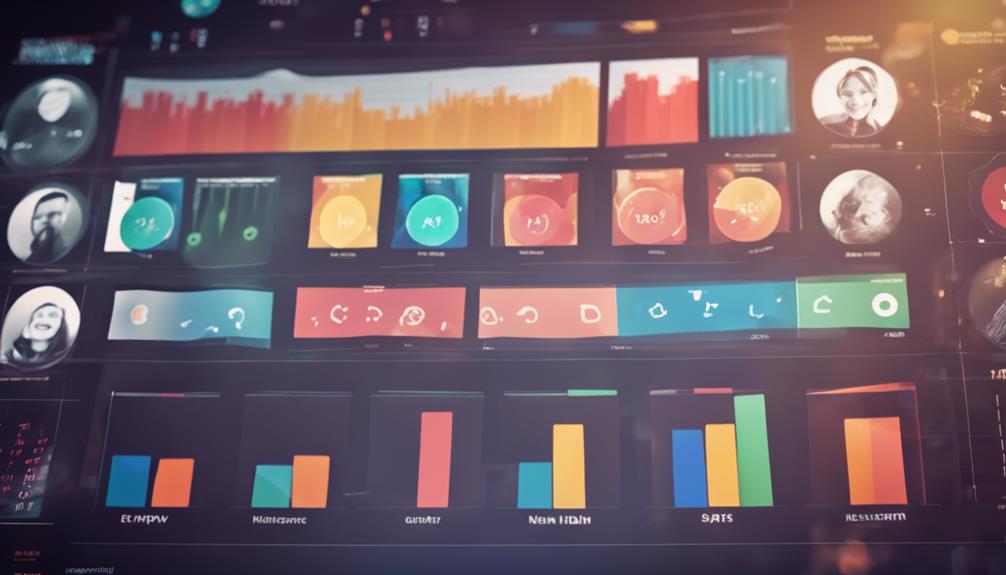I leverage sentiment analysis in marketing by choosing the right AI tools like Monkeylearn or Lexalytics for precise feedback categorization. Integrating human judgment guarantees nuanced insights, especially with idioms and sarcasm. I analyze customer feedback to tailor strategies and monitor social media sentiment for real-time reactions. Applying these insights to campaigns helps connect emotionally with the audience. I track competitor sentiment to inform strategic positioning and measure campaign effectiveness by comparing sentiment scores across platforms. Each step enhances my strategies, making them data-driven and customer-focused. Explore how these elements work together for a thorough marketing approach.
Key Takeaways
- Combine AI tools and human judgment to capture nuanced customer emotions and improve sentiment analysis accuracy.
- Train your team to interpret emotional cues and context-specific nuances for a deeper understanding of customer feedback.
- Use sentiment analysis to tailor marketing campaigns to the emotional tones and preferences of your target audience.
- Track sentiment trends to identify evolving customer opinions and adjust your marketing strategies accordingly.
- Monitor competitor sentiment to benchmark performance and inform strategic positioning for your brand.
Choose the Right AI Tools
When diving into sentiment analysis for marketing, I'll need to choose AI tools like Monkeylearn, Lexalytics, or Talkwalker to guarantee accurate and actionable insights. Sentiment analysis tools are pivotal in interpreting customer emotions and standardizing sentiment analysis, which directly impacts effective marketing strategies.
Monkeylearn excels with automatic feedback categorization, ideal for competitive intelligence.
Lexalytics supports sentiment analysis in 29 languages, broadening our global reach.
Talkwalker's AI-powered sentiment analysis, real-time trend identification, and content ideation capabilities provide a thorough toolkit for understanding customer emotions.
Selecting the right AI tool is essential. It ensures precise sentiment interpretation, fostering data-driven decisions and innovative marketing approaches. This choice underpins our ability to craft tailored and impactful marketing strategies.
Integrate Human Judgment
Integrating human judgment with automated sentiment analysis is essential for capturing the emotional nuances that algorithms might miss. By balancing automation with human intuition, we can guarantee that context is accurately interpreted.
Training teams to provide these insights will greatly enhance the accuracy and quality of our sentiment analysis.
Balance Automation With Intuition
Balancing automated sentiment analysis with human judgment guarantees a thorough understanding of customer emotions. Human intuition captures intricate nuances that algorithms might overlook. Automated tools can swiftly process vast amounts of customer sentiment data, but they often miss subjective nuances that are critical for effective interpretations.
By integrating human judgment, we can interpret complex emotions and contextual subtleties, ensuring our marketing strategies are more aligned with actual customer sentiment. This balance between automation and human insight not only enhances the accuracy of our analyses but also tailors our approaches to meet customer needs more effectively.
Leveraging both elements empowers us to craft innovative, data-driven strategies that resonate deeply with our audience's true sentiments.
Context Matters in Analysis
Human judgment plays a pivotal role in sentiment analysis, enabling us to interpret context-specific nuances that automated tools often miss. Leveraging sentiment analysis effectively requires understanding customer emotions and the sentiment expressed in their communications. Contextual understanding enhances our ability to gauge customer sentiment accurately, ensuring our marketing strategies meet their needs.
Consider the following:
- Sarcasm Detection: Automated tools often misinterpret sarcasm, but human judgment can identify it.
- Idioms and Slang: Cultural references and idiomatic expressions need human interpretation for accurate sentiment analysis.
- Emotional Nuances: Humans can perceive the subtle emotions behind words.
- Contextual Relevance: Understanding the situation or background context is essential.
- Empathy: Human judgment adds emotional intelligence, enhancing the power of sentiment analysis.
Training Teams for Insights
Training our teams to interpret emotional nuances in customer communications greatly enhances the accuracy and depth of sentiment analysis. By integrating human judgment with automated sentiment analysis, we can better understand subtle expressions like sarcasm and irony. This combination guarantees more nuanced interpretations of customer emotions, providing valuable context to ambiguous sentiments. Effective sentiment analysis training equips our teams to decipher emotional cues, resulting in richer customer insights. Let's explore the benefits:
| Benefit | Description | Outcome |
|---|---|---|
| Improved Accuracy | Human judgment captures nuances algorithms miss | Fewer misinterpretations |
| Enhanced Depth of Insights | Training teams can detect subtle emotional cues | Deeper understanding of customer emotions |
| Balanced Approach | Combines automated and human analysis | Thorough sentiment evaluations |
Human judgment's role in sentiment analysis is pivotal for innovative marketing strategies.
Analyze Customer Feedback

When I analyze customer feedback using sentiment analysis, I can identify common themes and gauge the emotional tone of responses.
This data-driven approach lets me track sentiment trends over time, providing valuable insights into customer satisfaction.
Identify Common Themes
By leveraging sentiment analysis to scrutinize customer feedback, we can systematically identify common themes and patterns that reveal key insights into customer sentiments and preferences. This involves delving into the opinions, emotions, and attitudes expressed by customers to uncover recurring issues and prevalent topics. Such insights are invaluable for informed decision-making and crafting tailored marketing strategies.
Here are some key benefits:
- Recognition of recurring issues: Pinpointing frequent complaints or praises.
- Understanding customer preferences: Identifying what customers like or dislike.
- Enhanced decision-making: Using data-driven insights to guide marketing efforts.
- Prioritization of improvements: Focusing on areas that need immediate attention.
- Tailored marketing strategies: Customizing campaigns to align with customer sentiments.
Gauge Emotional Tone
To accurately gauge the emotional tone of customer feedback, we must employ sentiment analysis tools to meticulously categorize and quantify the expressed emotions, whether they are positive, negative, or neutral. By analyzing customer feedback, we gain valuable insights into their emotional tone, which is important for tailoring marketing strategies that resonate with our audience. Addressing customer concerns can greatly improve brand perception, enhance customer experiences, and ultimately drive business growth. Here's a quick snapshot of how sentiment analysis can be applied:
| Emotion | Positive Impact | Negative Impact |
|---|---|---|
| Positive | Boosts brand loyalty | Missed opportunities |
| Neutral | Stable brand perception | Indifference |
| Negative | Identifies areas to fix | Damages brand perception |
Using these insights, we can proactively improve our brand perception and foster stronger customer relationships.
Track Sentiment Trends
Building on our understanding of emotional tone, tracking sentiment trends over time allows us to identify evolving customer opinions and preferences with precision. By analyzing customer feedback, we can discern patterns in sentiment that reveal changing perceptions. This detailed, data-driven approach empowers us to make informed, strategic marketing decisions tailored to our target audience's evolving needs.
Key benefits of tracking sentiment trends include:
- Identifying shifts in customer opinions
- Adapting marketing strategies to align with customer sentiments
- Understanding the impact of campaigns on customer emotions
- Predicting future customer behaviors based on sentiment analysis
- Refining product offerings to meet changing customer preferences
Leveraging sentiment analysis to track sentiment trends guarantees our marketing remains innovative and responsive to our audience's needs.
Monitor Social Media Sentiment
How can businesses effectively harness social media sentiment analysis to gain actionable insights into customer behavior and preferences? By leveraging sentiment analysis tools, I can track customer sentiments across platforms like Twitter, Facebook, and Instagram. This enables me to monitor sentiment trends and respond to customer feedback in real-time, enhancing brand reputation and marketing efforts. Here's a detailed look:
| Aspect | Benefit |
|---|---|
| Sentiment Analysis | Tracks customer sentiments and trends |
| Social Media | Monitors platforms like Twitter and Facebook |
| Customer Feedback | Responds to feedback in real-time |
| Brand Reputation | Manages online reputation proactively |
Analyzing social media sentiment reveals customer preferences, satisfaction levels, and areas for improvement. This data-driven approach ensures that marketing strategies align with customer sentiments, driving innovation and growth.
Apply Insights to Campaigns

Leveraging sentiment analysis insights, I can tailor marketing campaigns to align with the emotional nuances and opinions of our target audience. By analyzing customer feedback, I identify key themes that drive personalized campaigns. This allows me to adjust our messaging, visuals, and tone for best engagement.
- Optimize ad targeting based on identified emotional triggers.
- Use A/B testing to measure the impact of different emotional appeals.
- Enhance campaign performance by aligning messaging with customer sentiment.
- Develop tailored marketing campaigns that resonate deeply with our audience.
- Leverage data for precise messaging optimization.
Track Competitor Sentiment
By analyzing competitor sentiment, I can uncover critical insights into market dynamics and customer preferences. Competitor sentiment analysis provides a detailed look into customer perceptions and preferences, allowing me to identify trends and stay ahead in the competitive landscape. By benchmarking competitor performance, I can refine my strategic positioning and inform my marketing strategies to improve brand positioning.
Here's a snapshot of the benefits:
| Benefit | Description | Impact |
|---|---|---|
| Customer Perceptions | Understand how customers view competitors | Tailor strategies to meet customer needs |
| Preferences | Identify what customers prefer | Enhance product and service offerings |
| Trends | Spot emerging trends in the market | Adapt quickly to stay competitive |
Utilizing competitor sentiment analysis, I can strategically position my brand to capture market opportunities and fortify my marketing strategies.
Measure Campaign Effectiveness

To guarantee campaign effectiveness, I analyze the sentiment of customer feedback, social media mentions, and reviews using advanced sentiment analysis tools. Tracking changes in sentiment before, during, and after marketing campaigns allows me to gauge their impact accurately. I identify key themes and emotions expressed by customers to refine our messaging and branding.
By comparing sentiment scores across different channels, I determine which platforms drive the most positive sentiment. This data-driven approach helps me make real-time adjustments to our marketing strategies and optimize campaign effectiveness.
Key actions include:
- Analyzing sentiment trends in customer feedback
- Monitoring social media mentions for immediate reactions
- Evaluating reviews for long-term sentiment changes
- Comparing sentiment scores across platforms
- Identifying emotions expressed for targeted adjustments
This approach guarantees we stay aligned with our target audience's sentiments.
Frequently Asked Questions
How Can Marketers Use Sentiment Analysis?
I can use sentiment analysis to interpret customer feedback from social media, refine ad campaigns, and manage brand reputation. It aids in competitor analysis, shapes content strategy, monitors market trends, and optimizes product launches and crisis management.
What Is the Best Approach for Sentiment Analysis?
The best approach for sentiment analysis marries machine learning with data preprocessing and hybrid models. Utilizing deep learning for contextual analysis, feature extraction, and text mining, I leverage rule-based and lexicon-based methods to achieve precise sentiment scoring.
What Are the Four Main Steps of Sentiment Analysis?
The four main steps of sentiment analysis include data collection, text preprocessing, sentiment classification, and interpreting results. This involves opinion mining, emotion detection, aspect extraction, polarity determination, algorithm selection, and model training to yield actionable insights.
How to Analyze Sentiment Analysis?
Imagine sentiment analysis as mining for gold in text data. I start with data preprocessing, followed by text tokenization and feature extraction. Then I use sentiment lexicons and machine learning for sentiment classification, opinion mining, and emotion detection.
Conclusion
Incorporating sentiment analysis into marketing isn't just smart; it's essential. Did you know that businesses using sentiment analysis can see up to a 20% increase in customer satisfaction?
By selecting the right AI tools, blending in human insight, and closely monitoring both customer and competitor sentiment, we can craft data-driven campaigns that truly resonate.
Let's not forget to measure effectiveness to fine-tune our strategies continuously. The numbers speak for themselves—let's leverage them.






